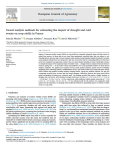Mendes C., Aldebert K., Brun F., Makowski D. (2025). Causal analysis methods for estimating the impact of drought and cold events on crop yields in France. European Journal of Agronomy, 01/01/2025, vol. 170, p. 127743.
https://doi.org/10.1016/j.eja.2025.127743
https://doi.org/10.1016/j.eja.2025.127743
| Titre : | Causal analysis methods for estimating the impact of drought and cold events on crop yields in France (2025) |
| Auteurs : | C. Mendes ; K. Aldebert ; F. Brun ; D. Makowski |
| Type de document : | Article |
| Dans : | European Journal of Agronomy (vol. 170, 2025) |
| Article en page(s) : | p. 127743 |
| Langues : | Anglais |
| Langues du résumé : | Anglais |
| Catégories : |
Catégories principales 07 - ENVIRONNEMENT ; 7.5 - Dégradation : Impact, DésertificationThésaurus IAMM SECHERESSE ; ACCIDENT CLIMATIQUE ; FROID ; RENDEMENT DES CULTURES ; EVALUATION DE L'IMPACT ; FRANCE |
| Résumé : | Impacts of extreme weather events (EWEs) on crop yields are commonly estimated using yield time series obtained from surveys. As these data do not come from randomized controlled trials, they are subject to confounding factors and may lead to biased estimates when analyzed using standard statistical methods. Recently, causal analysis methods have been proposed to take into account the risks of confounding effects, but they have never been compared in an agronomic context. Here, we used a dataset including 23 years of yield data in France to estimate the impact of two important types of weather events — drought events in summer (DE) and cold wave events in spring (CE) — on the yields of maize and sunflower, two crops potentially sensitive to these adverse weather conditions. We applied and compared several causal analysis methods, namely Inverse Probability Weighting (IPW), Matching (Match), Standardization (SDZ), and Double Robust (DR) using both linear mixed-effects models and gradient boosting machine learning models. Among the methods assessed, DR and SDZ consistently provided more accurate and less biased estimates. Differences between the linear mixed effects model and gradient boosting were relatively small. Our findings revealed that maize is highly sensitive to droughts and cold waves, with estimated average yield losses in France of −11.6 % (95 % CI = [−15.4 %, −9.3 %]) and −11.3 % [−14.6 %, −8.9 %], respectively, while sunflower exhibits smaller reductions of −7.3 % [−10.1 %, −5.7 %] and −6.9 % [−8.6 %, −4.0 %], estimated with the DR method. Our comparative study underscores the importance of adopting robust analytical methods for quantifying impacts of extreme weather events on crop yields. |
| Cote : | Réservé lecteur CIHEAM |
| URL / DOI : | https://doi.org/10.1016/j.eja.2025.127743 |







